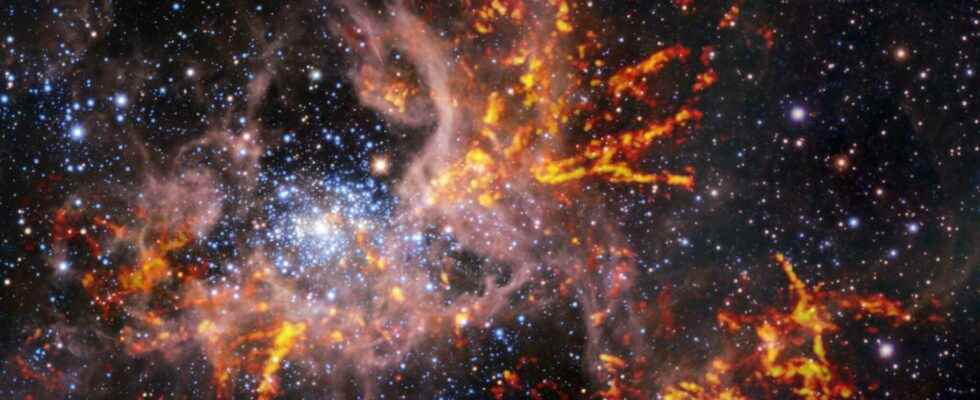To better understand the birth of stars, astrophysicists can use the Alma radio telescope network in addition to other instruments. They regularly look into the case of the nursery of young stars of 30 Doradus, also known as the Tarantula Nebula. ESO today presents new high-resolution observations covering a large region of the nebula. Alma, by measuring the radiation coming from molecules of carbon monoxide gas in the nebula, allowed them to map its large clouds of cold gas collapsing to give birth to new stars.
In its quest for its origins, the noosphere is unfortunately unable to reproduce on an astronomical scale the conditions of the birth of the Solar system from thecollapse of a molecular cloud in the Milky Way more than 4.5 billion years ago. But fortunately theUniverse observable takes care of doing these experiments for us under various conditions, as if we controlled them at will to better understand the causes and the results by varying parameters while the others remain constant.
For a long time, among the natural celestial laboratories considered, there is the nebula of the Tarantula – one of the regions of formation ofstars the brightest and most active in our galactic neighborhood. Also called 30 Doradus, or NGC 2070, it is indeed at about 170,000 light years of our Galaxy, in the famous Large Magellanic Cloud. It is also not far from 30 Doradus that the famous supernova 1987A.
This zoom video begins with a wide view of the Milky Way and ends with a close-up of a rich region of star formation in the nearby Large Magellanic Cloud in the southern constellation of Dorade. The specific region shown, 30 Doradus, is also known as the Tarantula Nebula. The final view of these clouds was captured by ESO’s VLT and Vista, and overlaid with new radio data taken by Alma. Alma data reveals bright yellow-red streaks of cool, dense gas that have the potential to collapse and form new stars. © ESO/Digitized Sky Survey 2/N. Risinger (skysurvey.org)/R. Gendler (http://www.robgendlerastropics.com/), Alma (ESO/NAOJ/NRAO)/Wong et al., ESO/M.-R. Cioni/Vista Magellanic Cloud survey. Acknowledgment: Cambridge Astronomical Survey Unit. Music: John Dyson
A laboratory to understand the birth of the first stars of 150 solar masses
The astrophysicists study the Tarantula Nebula at various wavelengths and with instruments as diverse as Hubblethe Very Large Telescope (VLT) of the’ESO in the visible, Alma (Atacama Large Millimeter/submillimeter Array) in the wave domain radio or with theInfrared Survey Telescope for Astronomy (Vista) in L’infraredalso from ESO.
More and more detailed combinations of images and the accompanying articles, analyzing these images, are periodically brought to the fore as the high image resolution published today by the European Southern Observatory (ESO) and including data from Alma while accompanying an article in The Astrophysical Journal which can be consulted freely at arXiv .
In the ESO press release that accompanies the publication, Guido De Marchi, researcher at the European Space Agency (ESA) and co-author of the article explains that ” what makes 30 Doradus unique is that it is close enough for us to study in detail how stars form, and its properties are similar to those found in galaxies very far away, when the Universe was young. Thanks to 30 Doradus, we can study how stars formed 10 billion years ago, when most stars were born“.
This video begins with a view of the star-forming region 30 Doradus in visible wavelengths, taken with ESO’s 2.2-meter telescope at La Silla Observatory. During the video, the image switches to an infrared view of the Tarantula Nebula. Infrared data is provided by ESO’s VLT and Vista and reveals pinkish clouds of hot gas. The radio data taken by Alma is then overlaid, represented by bright red-yellow bands. These bands highlight the location of clouds of cold, dense gas that have the potential to collapse and form new stars. The X-ray data is then presented on its own, showing in detail some of the spidery structures that gave rise to the nickname Tarantula Nebula. © ESO, M. Kornmesser, Alma (ESO/NAOJ/NRAO)/Wong et al., ESO/M.-R. Cioni/Vista Magellanic Cloud survey. Acknowledgment: Cambridge Astronomical Survey Unit
Interested in what you just read?
